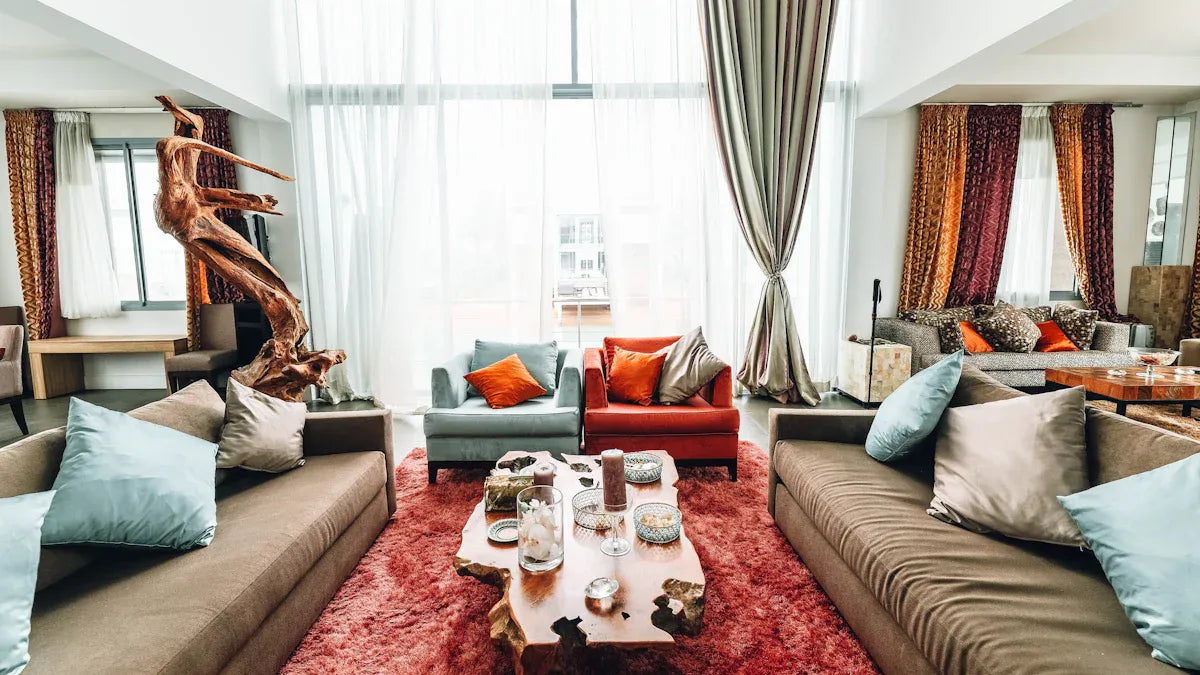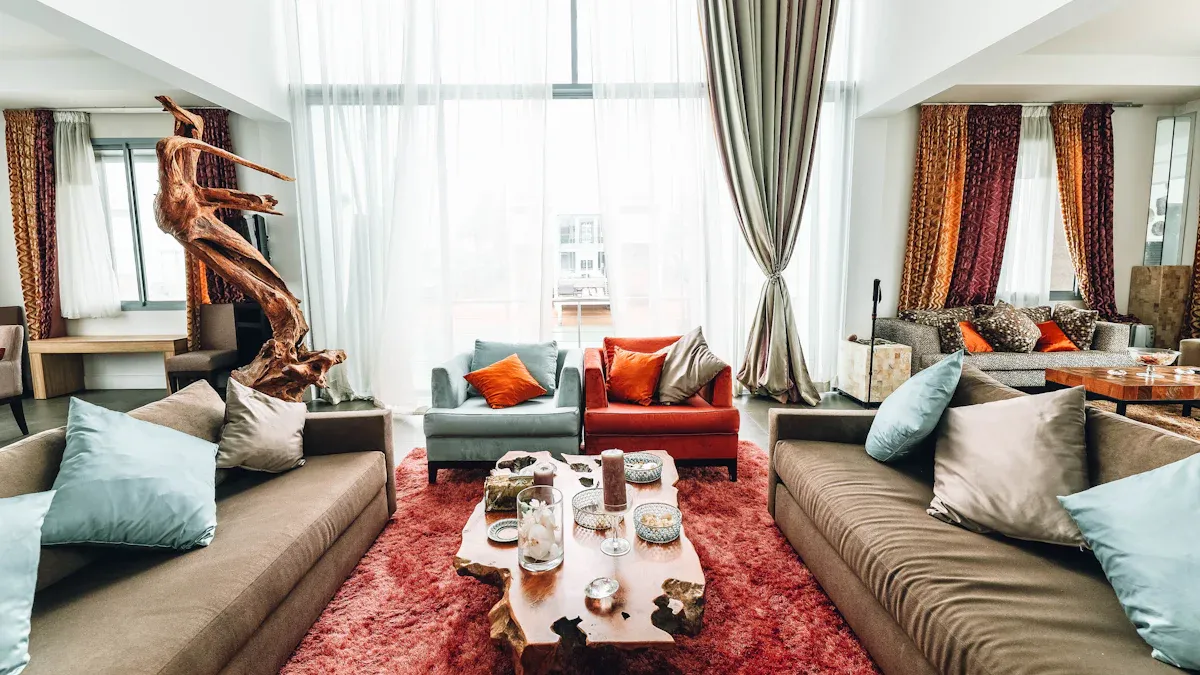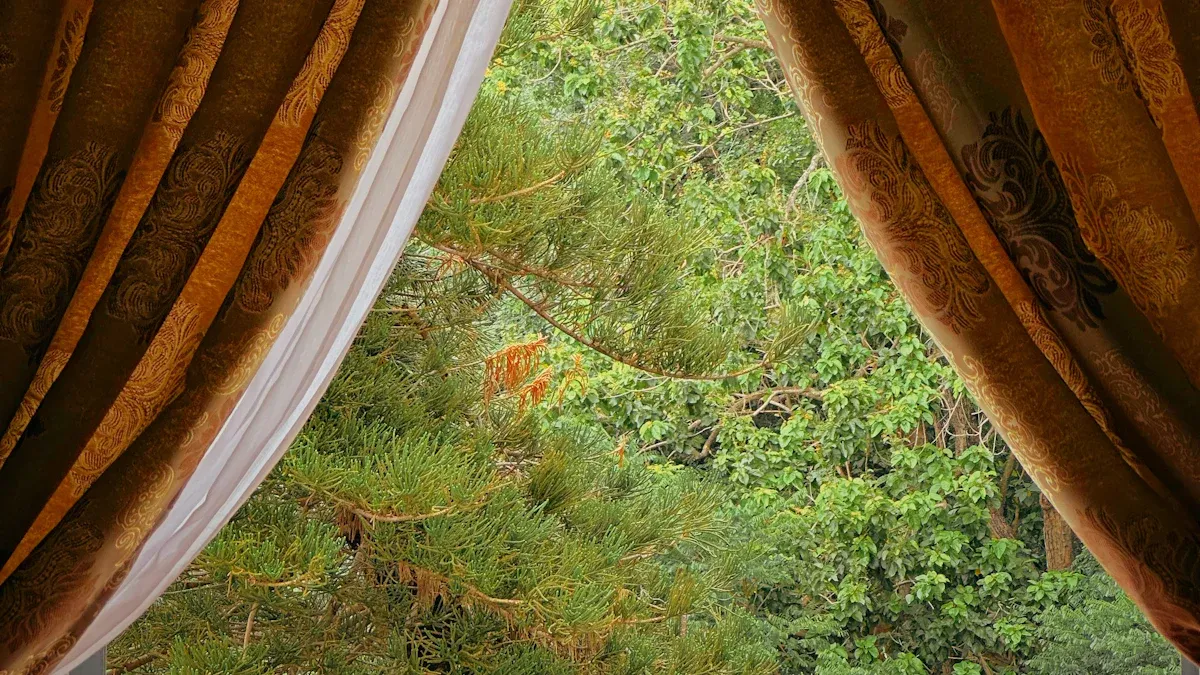
How to Choose the Perfect Custom Drapes for Your Home in 2025

Choosing the perfect custom drapes for your home in 2025 might feel overwhelming, but it’s easier than you think. It’s all about finding the right balance between style, functionality, and that personal touch. With the curtains and window blinds market projected to hit $26.6 billion in 2025, it’s clear that more homeowners are investing in tailored window treatments to elevate their spaces. Whether you’re drawn to organic fabrics or prefer bold, layered designs, customization ensures your drapes fit your needs and reflect your personality. Why settle for less when your windows can make a statement?
Key Takeaways
Figure out your home’s style to pick matching drapes. Think about modern, classic, or boho looks.
Pick drape styles that are trendy, like pinch pleats or grommets. These can make your home look cool.
Remember practical needs like privacy and light control. Blackout drapes are great for bedrooms. Sheer ones let sunlight in.
Choose good fabrics that are easy to clean. Washable or stain-proof ones are best if you have kids or pets.
Get expert help to hang drapes right. This makes them fit well and last longer.
Understanding Your Design Style
When it comes to custom drapes, understanding your design style is the first step to creating a cohesive and inviting space. Your drapes should feel like an extension of your home’s personality, blending seamlessly with the overall aesthetic. Let’s explore how you can identify your home’s style, match it to popular drape trends, and ensure everything works together beautifully.
Identifying Your Home’s Aesthetic
Take a moment to look around your home. What stands out? Is it sleek and modern, or does it have a cozy, rustic vibe? Identifying your home’s aesthetic helps you choose drapes that complement the space rather than clash with it. For example:
Modern homes often pair well with clean lines and neutral tones.
Traditional spaces shine with rich fabrics like velvet or silk.
Bohemian styles embrace bold patterns and layered textures.
If you’re unsure, think about the colors, furniture, and overall vibe of your rooms. Your drapes should enhance these elements, not compete with them.
Tip: Snap a few photos of your space and compare them to design inspiration online. This can help you pinpoint your style more easily.
Matching Custom Drapes to Popular Styles
Once you’ve identified your aesthetic, it’s time to explore drape styles that are trending in 2025. Custom drapes are more than just functional—they’re a design statement. Here’s a quick look at some of the most popular styles and their rankings:
Trend Description |
Popularity Rank |
|---|---|
1 |
|
2 |
|
Drapery hooks and rings |
3 |
Ripplefold draperies |
N/A |
Layering draperies |
N/A |
Linen and woven shades |
N/A |
Solid drapes and sheers |
N/A |
Pinch pleats and grommets are leading the way, offering a polished and timeless look. If you prefer something more casual, ripplefold draperies or layered styles might be the perfect fit. Haley Weidenbaum, founder of Everhem, highlights how custom drapes are becoming a focal point in interior design, with detailed craftsmanship and unique textures taking center stage.
Ensuring Harmony with Existing Décor
Your drapes should feel like they belong in the room. To achieve this, focus on harmony. Match the fabric and color of your drapes to the tones and textures already present in your space. For example:
If your room features soft, neutral tones, opt for drapes in a similar palette.
For bold, colorful spaces, consider solid drapes that balance the vibrancy.
Add trim or fringe for a touch of elegance, as designers are increasingly focusing on these details.
Remember, the goal is to enhance your space, not overwhelm it. By choosing drapes that align with your existing décor, you’ll create a room that feels cohesive and well-thought-out.
Note: Custom drapes allow you to tailor every detail, from fabric to finishings, ensuring they fit your space perfectly.
Practical Factors to Consider
When choosing custom drapes, it’s not just about how they look. You also need to think about how they’ll work in your space. From privacy to energy efficiency, practical factors play a big role in making the right choice. Let’s dive into the key considerations.
Room Function and Privacy Needs
Every room in your home serves a different purpose, and your drapes should reflect that. For example, the drapes in your bedroom might need to block out light completely, while those in your living room could focus more on style and letting in natural light. Here are some factors to keep in mind:
Factor |
Description |
|---|---|
UV-blocking materials |
Protects furnishings from fading due to sun exposure. |
Blackout solutions |
Essential for bedrooms to ensure complete darkness and prevent light leakage. |
Enhanced privacy features |
Provides additional privacy in various room settings. |
Noise reduction capabilities |
Helps in minimizing sound disturbances, enhancing comfort. |
If you’re looking for privacy, blackout drapes are a great option, especially for bedrooms or media rooms. On the other hand, sheer drapes can work well in spaces where you want to let in light but still maintain some level of privacy. Think about how you use each room and choose drapes that meet those needs.
Tip: If you live in a busy area, consider drapes with noise-reducing capabilities. They can make your home feel like a peaceful retreat.
Light Control and Energy Efficiency
Drapes do more than just cover your windows—they can also help control light and save energy. The type of fabric and color you choose can make a big difference. Here are some key points to consider:
Draperies can significantly reduce heat loss and gain depending on fabric type and color.
Medium-colored draperies with white-plastic backings can reduce heat gains by 33%.
Conventional draperies can reduce heat loss from a warm room by up to 10% when drawn during cold weather.
Hunter Douglas has long focused on making a difference by saving energy at the window, having invented energy-efficient Duette® Honeycomb Shades in 1985. Their commitment to getting AERC ratings in 2020 shows that they continue to think about the impact window treatments can make, helping homeowners select shades that best fit their lifestyles.
AERC provides an un-biased, third-party certification of the energy-saving potential of a window attachment product. It uses a sophisticated process of material testing and window modeling to gauge how well a window attachment—such as a shade, blind, or storm window—improves the performance of that window in reducing heating and cooling usage.
If energy efficiency is a priority for you, look for drapes with insulating properties. They can help keep your home cool in the summer and warm in the winter, saving you money on energy bills.
Maintenance and Durability
Let’s face it—no one wants drapes that are hard to clean or fall apart after a few years. When choosing custom drapes, think about how much maintenance you’re willing to handle and how durable the materials are. Here are some tips:
Choose washable fabrics: If you have kids or pets, opt for fabrics that are easy to clean. Cotton and polyester blends are great options.
Consider stain-resistant treatments: These can help your drapes stay looking fresh, even in high-traffic areas.
Think about wear and tear: Heavier fabrics like velvet or wool tend to last longer, but they might require professional cleaning.
Note: Custom drapes are an investment, so it’s worth spending a little extra on high-quality materials that will stand the test of time.
By considering these practical factors, you’ll not only enhance the functionality of your drapes but also ensure they look great for years to come.
Choosing the Right Fabric and Color

When it comes to custom drapes, the fabric and color you choose can make or break your design. They don’t just affect how your drapes look but also how they function in your space. Let’s dive into how you can select the perfect fabric and color to elevate your home.
Selecting Fabrics for Style and Functionality
The fabric you choose should match both your style and your needs. Some fabrics are lightweight and casual, while others are heavy and luxurious. Here’s a quick guide to help you decide:
Fabric Type |
Benefits |
Best Use |
|---|---|---|
Sheer |
Minimal privacy, pairs well with heavier panels |
Casual spaces |
Cotton |
Breathable, lightweight, machine-washable |
Kitchens, bedrooms |
Linen |
Natural luster, quick-drying |
Living rooms, beach houses |
Silk |
Elegant sheen, reflects light |
Luxurious spaces |
Wool |
Excellent insulation, noise-reducing |
Colder regions |
Polyester |
Durable, wrinkle-resistant, inexpensive |
Busy spaces, rentals |
For a relaxed vibe, linen or cotton works beautifully. If you want something more formal, silk or velvet adds a touch of elegance. Think about how much light you want to filter and how much maintenance you’re willing to handle.
Picking Colors That Complement Your Space
Color is key to tying your room together. You can use color theory to create harmony or contrast. Here are some popular color schemes to consider:
Monochromatic: Stick to one hue with different shades and tints for a cohesive look.
Analogous: Combine three colors next to each other on the color wheel for a soft, blended effect.
Complementary: Pair opposite colors, like blue and orange, for a bold statement.
Triadic: Use three evenly spaced colors for a balanced yet vibrant palette.
Colors also influence mood. For a calming effect, go for cool tones like blues and greens. Warm tones like yellows and reds can energize a space.
Adding Patterns and Textures for Depth
If you want your custom drapes to stand out, consider adding patterns or textures. Stripes, florals, or geometric designs can add personality to your room. Textures like velvet or woven fabrics create depth and make your drapes feel more luxurious. Just make sure the patterns and textures complement your existing décor.
Tip: If your room already has bold furniture or wallpaper, stick to solid-colored drapes to avoid overwhelming the space.
By carefully choosing the fabric, color, and texture, you’ll create custom drapes that not only look stunning but also serve your needs perfectly.
Customization and Construction Options
Exploring Pleating Styles and Tailored Fits
When it comes to custom drapes, pleating styles can make a big difference in how your windows look. Pleats aren’t just about function—they add personality to your drapes. For a classic and elegant vibe, pinch pleats are a timeless choice. If you prefer something modern, ripplefold pleats offer a sleek, minimalist look. Grommet tops, on the other hand, are perfect for casual spaces and make opening and closing your drapes a breeze.
Tailored fits are another game-changer. Unlike store-bought options, custom drapes are made to fit your windows perfectly. This means no awkward gaps or dragging fabric. Whether your windows are oversized, arched, or uniquely shaped, tailored drapes ensure a polished and professional finish.
Tip: Always measure your windows carefully or consult a professional to get the perfect fit.
Benefits of Truly Custom Drapes
Why go custom? The benefits are endless. Custom drapes let you choose every detail, from fabric and color to pleating style and length. This level of control ensures your drapes match your home’s aesthetic and meet your functional needs. They’re also made with higher-quality materials, which means they’ll last longer and look better over time.
Another major perk is the ability to solve specific challenges. Need blackout drapes for your bedroom? Or maybe you want sheer panels that let in light but still provide privacy? Custom options cater to your exact requirements, making them a smart investment for any home.
Adding Unique Details for Personalization
The beauty of custom drapes lies in the details. Adding unique touches can transform your drapes into a true reflection of your style. Consider incorporating decorative trims, tassels, or fringe for a touch of elegance. You can also play with textures and patterns to create visual interest. For example, pairing a bold geometric print with a soft velvet fabric can add depth and character to your space.
Personalization doesn’t stop at aesthetics. Functional details, like motorized tracks or UV-blocking linings, can make your drapes even more practical. By customizing these elements, you’re not just decorating your home—you’re enhancing its comfort and functionality.
Unique details like texture and pattern don’t just look good. They also contribute to the overall ambiance of your room, making it feel more personal and inviting.
Hardware and Installation Tips

When it comes to custom drapes, the hardware and installation process can make or break the final look. The right hardware not only supports your drapes but also enhances their style. Let’s explore how to choose complementary hardware, measure for a perfect fit, and decide between professional installation or a DIY approach.
Choosing Hardware That Complements Your Drapes
The hardware you choose should match the style and functionality of your drapes. It’s not just about looks—practicality matters too. Here are some tips to guide you:
Opt for rods and brackets that match your drape’s weight. Heavier fabrics like velvet need sturdy hardware to prevent sagging.
Choose finishes that complement your room’s décor. For example, brushed nickel works well in modern spaces, while antique brass adds charm to traditional rooms.
Look for hardware with clear installation instructions. Many products come with easy-to-follow guides, making the process manageable even for beginners.
Keep in mind that some setups may require an extra set of hands. This is especially true for larger windows or complex designs.
Tip: If you’re unsure about compatibility, consult a professional or the retailer for advice.
Measuring for a Perfect Fit
Accurate measurements are key to achieving a polished look. Follow these guidelines to ensure your drapes fit perfectly:
Measure from the top of the window trim to the floor. Adjust based on your desired drape length.
Add 8 inches to the width of your window on each side. This ensures the drapes fully cover the window when closed.
Extend the rod beyond the window frame by at least 8 inches. This creates the illusion of a larger window.
Plan for hem adjustments. For a tailored look, the hem should sit three-quarters of an inch above the floor.
Note: If you’re using linen drapes, hang them an inch higher than planned. Linen tends to relax over time, and this adjustment keeps them looking neat.
Professional Installation vs. DIY
Deciding between professional installation and DIY depends on your comfort level and the complexity of the project. Professional services can handle intricate setups, like motorized tracks or oversized windows. For example:
Project Name |
Location |
Description |
|---|---|---|
Custom Draper Support Structure |
Private Residence |
A custom support structure for a 174" diagonal Sony CLED home theater. |
FlexShade ZIP |
Dallas, TX |
Provides a barrier from the sun, weather, and insects on a poolside patio. |
Motorized FlexShade |
Richmond, IN |
Features Mermet E Screen Deco fabric in a private residence. |
If your project is straightforward, a DIY approach can save money. Just make sure you have the right tools and follow the instructions carefully.
Tip: For large or motorized installations, hiring a professional ensures a flawless finish and saves you time.
By choosing the right hardware, measuring accurately, and deciding on the best installation method, you’ll achieve custom drapes that look stunning and function perfectly.
Why Expert Guidance Matters
When it comes to custom drapes, expert guidance can make all the difference. From ensuring a flawless installation to helping you bring your vision to life, professionals offer valuable insights and skills that elevate your home’s design. Let’s explore why working with experts is worth it.
Advantages of Working with Professionals
Hiring professionals for your custom drapes isn’t just about convenience—it’s about quality and longevity. Here’s why it’s a smart choice:
Experts ensure your drapes are installed safely and securely, especially for heavy or complex designs.
They save you time by handling tricky setups, like motorized systems or oversized windows.
Professional installations can extend the lifespan of your drapes by up to 20%, according to industry surveys. This is especially important if you’ve invested in high-quality materials.
By working with professionals, you’ll enjoy peace of mind knowing your drapes are installed to perfection.
Communicating Your Vision Effectively
Sharing your design ideas with a custom drapery service can feel overwhelming, but it doesn’t have to be. Clear communication is key. Start by gathering inspiration—snap photos of your space, create a mood board, or use apps that let you visualize your drapes in real time. These tools help you show exactly what you’re looking for.
It’s also important to share your preferences, like fabric types, colors, or pleating styles. A good service will listen carefully and tailor their recommendations to your needs. When you feel understood, it’s easier to bring your vision to life.
Finding the Right Custom Drapery Service
Not all drapery services are created equal. To find the right one, look for a company that prioritizes customer satisfaction. Read reviews, ask for recommendations, and check if they offer personalized consultations. A great service will take the time to understand your style and guide you through the process.
You should also consider their expertise. Do they specialize in custom drapes? Can they handle unique requests, like motorized tracks or eco-friendly fabrics? Choosing a service with experience ensures you’ll get the best results.
Tip: Don’t hesitate to ask questions during your consultation. The right service will welcome your input and work with you to create drapes you’ll love.
Choosing the perfect custom drapes doesn’t have to be complicated. Start by understanding your home’s style and matching it with the right fabric, color, and pleating options. Think about practical needs like privacy, light control, and energy efficiency. Don’t forget to measure carefully and pick hardware that complements your design.
Custom drapes do more than look good. They help regulate temperature, block harsh sunlight, and even absorb sound, making your home more comfortable. Take your time exploring your preferences, and don’t hesitate to work with professionals. With the right choices, your drapes can transform your space into something truly special. 😊
FAQ
What’s the difference between custom drapes and ready-made ones?
Custom drapes are tailored to your exact window dimensions, style, and functional needs. Ready-made drapes come in standard sizes and designs, which may not fit perfectly or match your décor. Custom options give you more control over fabric, color, and details.
How do I choose the right length for my drapes?
Measure from the top of your window to the floor. For a modern look, let the drapes hover just above the floor. If you prefer a dramatic effect, allow them to puddle slightly. Always consider your room’s style and practicality.
Are custom drapes worth the investment?
Absolutely! Custom drapes last longer, fit perfectly, and enhance your home’s style. They also offer better functionality, like improved light control and energy efficiency. While they cost more upfront, their durability and tailored design make them a smart long-term choice.
Can I install custom drapes myself?
Yes, but it depends on the complexity. Simple setups with standard rods are DIY-friendly. For motorized tracks or oversized windows, professional installation ensures a flawless finish. If you’re unsure, consult a pro to save time and avoid mistakes.
How do I maintain my custom drapes?
Follow the care instructions provided by the manufacturer. Most fabrics can be vacuumed with a brush attachment. For deeper cleaning, consider professional services. If you have kids or pets, choose washable or stain-resistant fabrics for easier maintenance.
Tip: Regular cleaning prevents dust buildup and keeps your drapes looking fresh.










